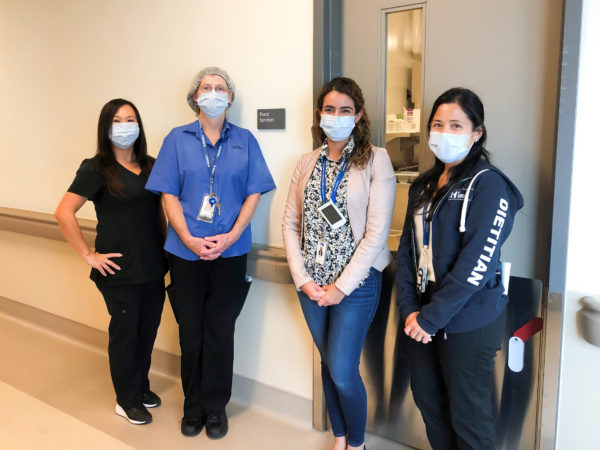Malnutrition Awareness in the Time of COVID-19
08
Oct
2020
This October 5-9 is Malnutrition Awareness Week. We sat down with Registered Dietitians Peggy and Elaine, Dietary Aide Arlene and Patient Food Services Supervisor Paola to learn how they each play a role in preventing, detecting and treating the malnutrition of patients in the hospital.
 What are some facts about malnutrition that the average person may be unaware of?
What are some facts about malnutrition that the average person may be unaware of?
Elaine: Malnutrition is a serious concern because, with poor intake, you end up with weight loss, then muscle loss, then a lack of energy. All of these factors can contribute to a prolonged recovery from illness and the loss of independence. 45% of patients that come into the hospital are malnourished, which is caused either by poor nutrition at home for a long period of time or as a product of their disease. They are not eating well, and many times, it goes unrecognized. 75% of patients who are malnourished at admission are missed in the referral process and only 23% of patients in the hospital are actually referred to a dietitian. Malnourished patients typically have a longer length of stay by three days and are doubly more likely to be readmitted to the hospital and eight times more likely to die.
What do you do when the patient comes into the hospital to prevent malnutrition?
Peggy: When we are referred, we will do our nutrition assessment of the patient. . Pending our assessments, we may adjust the diet order or nutritional supplements, or recommend enteral l or parenteral nutrition support if it is appropriate or indicated. Since registered dietitians are not able to see every single patient, we rely heavily on feedback from the health care team, including the Dietary Aides and Patient Food Services. The food service staff deliver the meals and see what the patients are eating. It is extremely helpful when they let us know when someone is not eating. Nutrition screening is also extremely important. We currently have the Canadian Nutrition Screening Tool (CNST) embedded in one of the nursing assessments. The questions are “have you had involuntary weight loss in the past 6 months?” and “have you been eating less than usual in the past 2 weeks?”. A patient who answers yes to both of these questions may be at risk for malnutrition and should be referred to the RD.
How do Dietary Aides observe patients eating habits and relay that information to Patient Food Services?
Arlene: As Dietary Aides, we interact with patients multiple times a day and are able to see what exactly they are eating and not eating. The barriers to nutrition patient’s face can range from the inability to chew and swallow, the ability to open packages or even personal preference. Sometimes, meals are delivered when a patient has gone for a test and by the time they come back, the meal is cold. All of these things contribute to someone’s appetite and intake in the hospital. I observe these barriers and speak with the Patient Food Services Supervisors so that we can come up with solutions like requesting the Dietary Aides to assist with opening up packaging or adjusting the patient’s menu based on preference or tolerance.
Paola: Arlene and the other Dietary Aides let us know when a patient is not eating and we may be asked to go and speak with them to try to understand what those barriers to intake are. We can then work to accommodate the patient by making specific notes or instructions on their menus for the Dietary Aides delivering their meals. The communication between the Dietitians, Patient Food Services Supervisors and the Dietary Aides is crucial to maximizing patient nutrition in the hospital.
Has COVID-19 presented any interesting challenges to treating malnutrition in patients?
Peggy: Absolutely! Prior to COVID, families would often bring comfort foods from home and would take the time to help to feed their loved ones. As eating is a very social experience, many patients developed poor intake or appetite due to the lack of social interaction from family or friends. With COVID restrictions, communal dining, for example, at the RCC sites, had to stop.
Elaine: Patients with COVID-19 tend to have gastrointestinal symptoms, taste and smell changes, and increased difficulty breathing which makes eating very difficult. They might already be coming into hospital slightly malnourished and if they have other comorbidities, even more malnourished. The Dietitians know that COVID patients are at higher risk for malnutrition as they require more calories and protein so they are flagged in screening and we see them right away to put them on nutritional supplements.
Upon discharge, are there any resources provided to patients who were dealing with malnutrition?
Elaine: Depending on the patient case, we will communicate with the patient, family or caregiver to provide resources to help continue the good nutrition at home. If they are going home on nutrition support, we will provide some education. Our goal is for these patients to regain their independence while continuing to build on good nutrition habits. There are also community resources available and when appropriate we will recommend a dietitian to follow up with the patient at home.
Thank you to the Dietitians, Dietary Aides and Patient Food Services at Humber River Health for working together to promote good nutritional intake! Go to Nutrition Care in Canada for more information and how you can help!
